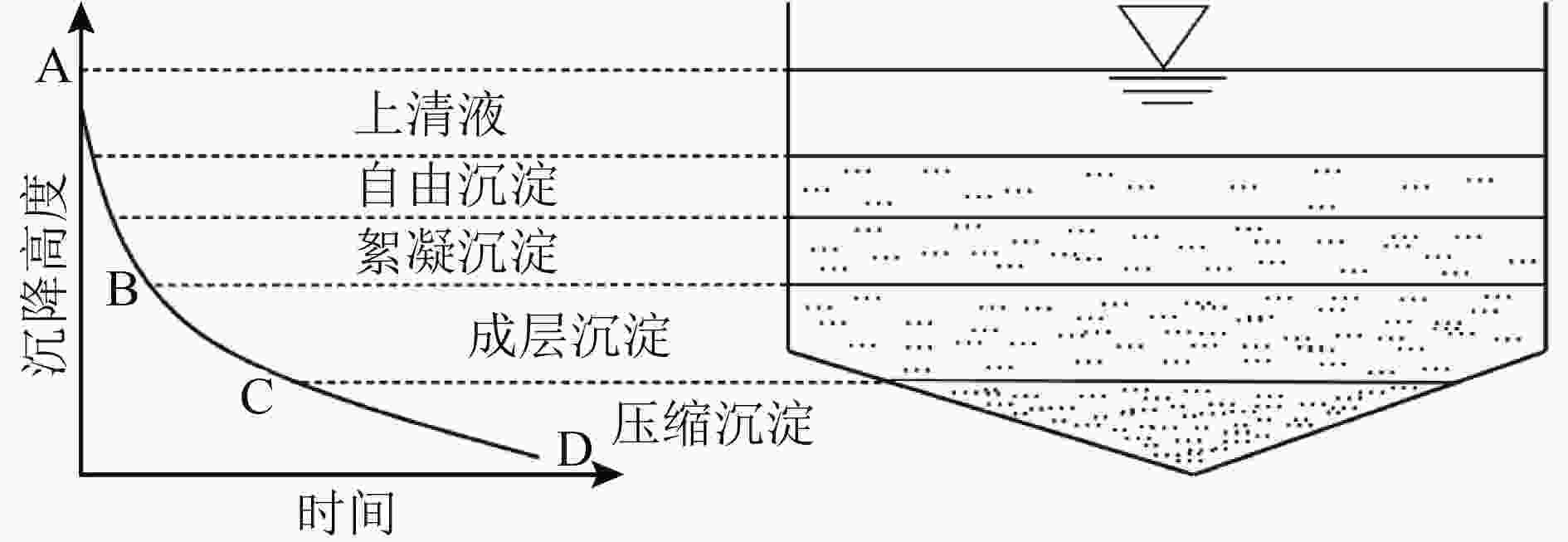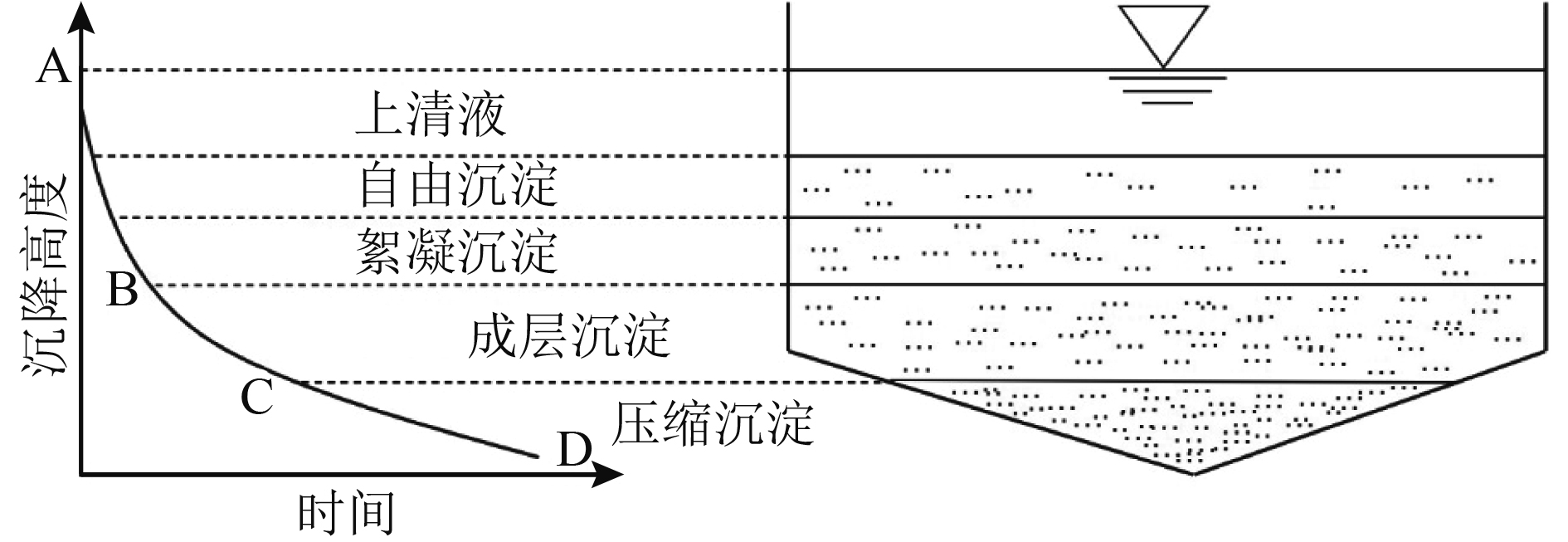Research progress of numerical model of secondary sedimentation tank in sewage treatment plant
-
摘要:
数值模型模拟在污水处理厂二沉池设计、运行操作和优化方面具有无可替代的优势,对现有数值模型进行归纳与总结对实际应用中选择及建立模型至关重要。介绍了用于二沉池数值模拟的欧拉-拉格朗日模型、欧拉-欧拉模型和混合模型等多相模型的原理,对各模型的适用性进行阐述,总结其优点和不足;阐述了单相模型在污泥沉降中的应用原理,提出单相模型通过耦合单独的固相输运方程来描述污泥沉降运动规律,其在二沉池污泥浓度分布预测上优于多相模型;论述了污泥沉降速度模型研究现状,其中包含利用批量沉降试验的污泥间歇沉降模型和描述污水处理厂二沉池连续流污泥沉降模型;较为系统地综述了二沉池污泥负荷、几何结构、温度等因素对二沉池内水质模拟结果的影响;最后对污水处理厂二沉池数学模型的选择和沉降模型后续研究进行了展望。
Abstract:Numerical model simulation has irreplaceable advantages in the design, operation, and optimization of the secondary sedimentation tank of the sewage treatment plant. It is very important to summarize existing numerical models for the selection and establishment of models in practical applications. The principles of multiphase models such as Euler-Lagrange model, Euler-Euler model, and Mixture model for numerical simulation of secondary sedimentation tank were introduced. The applicability of each model was described, the advantages and disadvantages of each model put forward, and the application principles of the single-phase model in sludge sedimentation explained. The single-phase model described the movement law of sludge sedimentation by coupling a single solid-phase transport equation, which was better than multiphase model in predicting the distribution of sludge mass concentration in the secondary sedimentation tank. The research status of the sludge sedimentation velocity model was discussed, including the model of intermittent sludge settlement using batch settlement test and the model of continuous flow sludge settlement describing the secondary sedimentation tank of the sewage treatment plant. The influence of sludge load, geometry structure, and temperature on water quality simulation of the secondary sedimentation tank was systematically reviewed. Finally, the selection of mathematical models for secondary sedimentation tank of the sewage treatment plant and future research on sedimentation models were prospected, to provide a theoretical basis and technical reference for the operation and design optimization of the secondary sedimentation tank of the sewage treatment plant.
-
表 1 二沉池建模多相模型概述
Table 1. Overview of the multiphase model for modelling secondary sedimentation tanks
模型 原理 计算方法 优缺点 E-L模型 通过欧拉方法处理液相,拉格朗日方法标记并追踪固体颗粒 用NS方程求解液相,计算NS方程和牛顿第二定律方程中的动量传递项 没有考虑悬浮物(SS)颗粒间的相互作用,追踪大量颗粒的计算成本较高 E-E模型 两相被当作单独的流体介质处理 连续相和离散相均采用NS方程求解,两相的方程由相体积分数耦合,且考虑两相的质量、动量、能量交换 计算工作量大,只能考虑有限数量且尺寸较小的颗粒;界面力通常是非线性的,因此有时迭代收敛会很困难[8] Mixture模型 两相被当作单相处理 对复杂混合流体仅使用一个动量方程,不考虑多相模型中的相间关系,采用代数方程求解两相之间的滑移速度来描述离散相 二沉池污泥沉降过程建模中未考虑存在大量粒径相差较大的固体颗粒,并且颗粒形状随着在二沉池流动过程中发生变化[9] VOF模型 两相被当作单独的流体介质处理,相间界面被追踪 通过连续性方程跟踪相间界面,并定义单相区域。对于每个域,求解一组带有动量交换项的特定相位NS方程 在研究二沉池上方风场的影响方面具有优势 -
[1] GAO H W, STENSTROM M K. The influence of wind in secondary settling tanks for wastewater treatment: a computational fluid dynamics study: part I. circular secondary settling tanks[J]. Water Environment Research,2020,92(4):541-550. doi: 10.1002/wer.1241 [2] GAO H W, STENSTROM M K. The influence of wind in secondary settling tanks for wastewater treatment: a computational fluid dynamics study: part II. rectangular secondary settling tanks[J]. Water Environment Research,2020,92(4):551-561. doi: 10.1002/wer.1244 [3] 刘朝晖. 四溴双酚A废水生化处理的工程研究及设计[D]. 天津: 天津大学, 2017. [4] NOPENS I, BATSTONE D J, GRIBORIO A, et al. Computational fluid dynamics (CFD): what is good CFD-modeling practice and what can be the added value of CFD models to WWTP modeling[J]. Proceedings of the Water Environment Federation,2012,2012(7):7400-7405. doi: 10.2175/193864712811704161 [5] VESILIND P A. Design of prototype thickeners from batch settling tests[J]. Water Sewage Works,1968,115(7):302-307. [6] TAKÁCS I, PATRY G G, NOLASCO D. A dynamic model of the clarification-thickening process[J]. Water Research,1991,25(10):1263-1271. doi: 10.1016/0043-1354(91)90066-Y [7] WICKLEIN E A, SAMSTAG R W. Comparing commercial and transport CFD models for secondary sedimentation[J]. Proceedings of the Water Environment Federation,2009,2009(10):6066-6081. doi: 10.2175/193864709793952765 [8] de CLERCQ B. Computational fluid dynamics of settling tanks: development of experiments and rheological, settling, and scraper submodels[D]. Belgium: Ghent University, 2003. [9] LIU X F, GARCÍA M H. Computational fluid dynamics modeling for the design of large primary settling tanks[J]. Journal of Hydraulic Engineering,2011,137(3):343-355. doi: 10.1061/(ASCE)HY.1943-7900.0000313 [10] KARPINSKA A M, BRIDGEMAN J. CFD-aided modelling of activated sludge systems: a critical review[J]. Water Research,2016,88:861-879. doi: 10.1016/j.watres.2015.11.008 [11] BURT D. Improved design of settling tanks using an extended drift flux model[R]. Bristol: University of Bristol. DOI: 10.13140/RG.2.1.5109.2082. [12] KYNCH G J. A theory of sedimentation[J]. Transactions of the Faraday Society,1952,48:166-176. doi: 10.1039/tf9524800166 [13] XANTHOS S, RAMALINGAM K, LIPKE S, et al. Implementation of CFD modeling in the performance assessment and optimization of secondary clarifiers: the PVSC case study[J]. Water Science and Technology,2013,68(9):1901-1913. doi: 10.2166/wst.2013.280 [14] XANTHOS S, GONG M W, RAMALINGAM K, et al. Performance assessment of secondary settling tanks using CFD modeling[J]. Water Resources Management,2011,25(4):1169-1182. doi: 10.1007/s11269-010-9620-1 [15] VERMA S, PRASAD B, MISHRA I M. Pretreatment of petrochemical wastewater by coagulation and flocculation and the sludge characteristics[J]. Journal of Hazardous Materials,2010,178(1/2/3):1055-1064. [16] 许春莲, 王文君, 胡学东, 等.缓释型除磷药剂在小型污水处理装置中的应用[J]. 环境工程技术学报,2013,3(6):527-531. doi: 10.3969/j.issn.1674-991X.2013.06.082XU C L, WANG W J, HU X D, et al. The application of sustained-release dephosphorization tablets to a small wastewater treatment plant[J]. Journal of Environmental Engineering Technology,2013,3(6):527-531. doi: 10.3969/j.issn.1674-991X.2013.06.082 [17] BÜRGER R. Phenomenological foundation and mathematical theory of sedimentation-consolidation processes[J]. Chemical Engineering Journal,2000,80(1/2/3):177-188. [18] KINNEAR D J. Biological solids sedimentation: a model incorporating fundamental settling parameters[D]. Salt Lake City: University of Utah, 2002. [19] de CLERCQ J, NOPENS I, DEFRANCQ J, et al. Extending and calibrating a mechanistic hindered and compression settling model for activated sludge using in-depth batch experiments[J]. Water Research,2008,42(3):781-791. doi: 10.1016/j.watres.2007.08.040 [20] PLÓSZ B G, WEISS M, PRINTEMPS C, et al. One-dimensional modelling of the secondary clarifier-factors affecting simulation in the clarification zone and the assessment of the thickening flow dependence[J]. Water Research,2007,41(15):3359-3371. doi: 10.1016/j.watres.2007.03.007 [21] PLÓSZ B G, DE CLERCQ J, NOPENS I, et al. Shall we upgrade one-dimensional secondary settler models used in WWTP simulators: an assessment of model structure uncertainty and its propagation[J]. Water Science and Technology:a Journal of the International Association on Water Pollution Research,2011,63(8):1726-1738. doi: 10.2166/wst.2011.412 [22] GUO L S, ZHANG D J, XU D Y, et al. An experimental study of low concentration sludge settling velocity under turbulent condition[J]. Water Research,2009,43(9):2383-2390. doi: 10.1016/j.watres.2009.02.032 [23] ABUSAM A, KEESMAN K J. Dynamic modeling of sludge compaction and consolidation processes in wastewater secondary settling tanks[J]. Water Environment Research,2009,81(1):51-56. doi: 10.1002/j.1554-7531.2009.tb00249.x [24] RENKO E K. Modelling hindered batch settling: part I. a model for linking zone setting velocity and stirred sludge volume index[J]. Water S A,1998,24(4):325-330. [25] DIEHL S, ZAMBRANO J, CARLSSON B. Steady-state analysis of activated sludge processes with a settler model including sludge compression[J]. Water Research,2016,88:104-116. doi: 10.1016/j.watres.2015.09.052 [26] ZHANG Y K, YIN X F, HE Z J, et al. Modeling the activated sludge: thickening process in secondary settlers[J]. International Journal of Environmental Research and Public Health,2015,12(12):15449-15458. doi: 10.3390/ijerph121214996 [27] ZHANG Y K, WANG H C, QI L, et al. Simple model of sludge thickening process in secondary settlers[J]. Frontiers of Environmental Science & Engineering,2016,10(2):319-326. [28] RAMIN E, WÁGNER D S, YDE L, et al. A new settling velocity model to describe secondary sedimentation[J]. Water Research,2014,66:447-458. doi: 10.1016/j.watres.2014.08.034 [29] BAKIRI Z, NACEF S. Development of an improved model for settling velocity and evaluation of the settleability characteristics[J]. Water Environment Research,2020,92(7):1089-1098. doi: 10.1002/wer.1306 [30] XU G H, YIN F J, XU Y J, et al. A force-based mechanistic model for describing activated sludge settling process[J]. Water Research,2017,127:118-126. doi: 10.1016/j.watres.2017.10.013 [31] PL'OSZ B G, NOPENS I, RIEGER L, et al. A critical review of clarifier modelling: state-of-the-art and engineering practices[EB/OL]. [2021-07-10]. https://modeleau.fsg.ulaval.ca/fileadmin/modeleau/documents/Publications/pvr993.pdf. [32] PARKER D S. Assessment of secondary clarification design concepts[J]. Water Pollution Control Federation,1983:349-359. [33] PARKER D S, KINNEAR D J, WAHLBERG E J. Review of folklore in design and operation of secondary clarifiers[J]. Journal of Environmental Engineering,2001,127(6):476-484. doi: 10.1061/(ASCE)0733-9372(2001)127:6(476) [34] VESTNER R J, WOLFGANG GÜNTHERT F. Influence of sludge properties and hydraulic loading on the performance of secondary settling tanks: full-scale operational results[J]. Water Science and Technology,2004,50(7):179-186. doi: 10.2166/wst.2004.0450 [35] GAO H W, STENSTROM M K. Computational fluid dynamics applied to secondary clarifier analysis[C]//World Environmental and Water Resources Congress 2017. Reston, VA, USA: American Society of Civil Engineers, 2017: 301-315. [36] GAO H W, STENSTROM M K. Evaluating the effects of inlet geometry on the limiting flux of secondary settling tanks with CFD model and 1D flux theory model[J]. Journal of Environmental Engineering,2019,145(10):04019065. doi: 10.1061/(ASCE)EE.1943-7870.0001582 [37] VITASOVIC Z C, ZHOU S P, MCCORQUODALE J A, et al. Secondary clarifier analysis using data from the Clarifier Research Technical Committee protocol[J]. Water Environment Research,1997,69(5):999-1007. doi: 10.2175/106143097X125696 [38] WAHLBERG E J, GERGES H Z, GHARAGOZIAN A, et al. Secondary clarifier analysis using data from the Clarifier Research Technical Committee protocol[J]. Water Environment Research,1998,70(2):249-253. doi: 10.2175/106143098X127107 [39] PATZIGER M. Computational fluid dynamics investigation of shallow circular secondary settling tanks: inlet geometry and performance indicators[J]. Chemical Engineering Research and Design,2016,112:122-131. doi: 10.1016/j.cherd.2016.06.018 [40] ROSTAMI F, SHAHROKHI M, MD SAID M A, et al. Numerical modeling on inlet aperture effects on flow pattern in primary settling tanks[J]. Applied Mathematical Modelling,2011,35(6):3012-3020. doi: 10.1016/j.apm.2010.12.007 [41] BOUISFI F, BOUISFI A, OUARRICHE H, et al. Improving removal efficiency of sedimentation tanks using different inlet and outlet position[J]. FME Transactions,2019,47(4):894-900. doi: 10.5937/fmet1904894B [42] KREBS P, VISCHER D, GUJER W. Improvement of secondary clarifiers efficiency by porous walls[J]. Water Science and Technology,1992,26(5/6):1147-1156. [43] RAMALINGAM K, FILLOS J, XANTHOS S, et al. Development and validation of a 3-dimensional computational fluid dynamics (CFD) model for rectangular settling tanks in New York City water pollution control plants[J]. Water Practice and Technology, 2008, 4(1). [44] VAHIDIFAR S, SAFFARIAN M R, HAJIDAVALLOO E. Introducing the theory of successful settling in order to evaluate and optimize the sedimentation tanks[J]. Meccanica,2018,53(14):3477-3493. doi: 10.1007/s11012-018-0907-2 [45] GERGES H, MCCORQUODALE A. Thirty years of sedimentation tanks modeling learning from experience[J]. Proceedings of the Water Environment Federation,2008,2008(15):1613-1619. doi: 10.2175/193864708788733729 [46] 赵东旭. 斜板沉淀池中固-液两相流水力特性数值模拟研究[D]. 西安: 西安理工大学, 2019. [47] WANG K Y, LI Y K, REN S M, et al. A case study on settling process in inclined-tube gravity sedimentation tank for drip irrigation with the Yellow River water[J]. Water,2020,12(6):1685. doi: 10.3390/w12061685 [48] GOULA A M, KOSTOGLOU M, KARAPANTSIOS T D, et al. The effect of influent temperature variations in a sedimentation tank for potable water treatment: a computational fluid dynamics study[J]. Water Research,2008,42(13):3405-3414. doi: 10.1016/j.watres.2008.05.002 [49] 魏文礼, 蔡亚希, 刘玉玲.温差对辐流式沉淀池水力特性影响的数值模拟[J]. 武汉大学学报(工学版),2016,49(1):9-15. doi: 10.14188/j.1671-8844.2016-01-002WEI W L, CAI Y X, LIU Y L. Numerical simulation of influence of temperature difference on hydraulic characteristics in radial flow sedimentation tank[J]. Engineering Journal of Wuhan University,2016,49(1):9-15. doi: 10.14188/j.1671-8844.2016-01-002 [50] 刘经凯, 刘振鸿.温度异重流对竖流式二沉池影响的三维数值模拟[J]. 土木工程,2020,9(4):265-276. doi: 10.12677/HJCE.2020.94029LIU J K, LIU Z H. Three-dimensional numerical simulation of the influence of temperature density flow on vertical secondary sedimentation tank[J]. Hans Journal of Civil Engineering,2020,9(4):265-276. doi: 10.12677/HJCE.2020.94029 [51] STAMOU A, GKESOULI A. Modeling settling tanks for water treatment using computational fluid dynamics[J]. Journal of Hydroinformatics,2015,17(5):745-762. doi: 10.2166/hydro.2015.069 [52] GOODARZI D, LARI K S, ALIGHARDASHI A. A large eddy simulation study to assess low-speed wind and baffle orientation effects in a water treatment sedimentation basin[J]. Water Science and Technology,2018,2017(2):412-421. doi: 10.2166/wst.2018.171 [53] GKESOULI A, STAMOU A. A CFD modeling procedure to assess the effect of wind in settling tanks[J]. Journal of Hydroinformatics,2019,21(1):123-135. ⊗ doi: 10.2166/hydro.2018.048 -





 下载:
下载:


